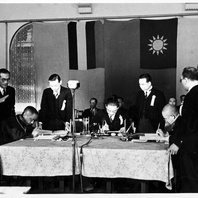
Item
Signing of Japan-Manchukuo-China Joint Declaration
Flanked by courtiers, Zang Shiyi, the Manchukuo ambassador to the RNG (seated to the left), Noboyuki Abe, Japanese ambassador to the RNG (seated to the right), and Wang Jingwei (seated in the centre) sign the Japan-Manchukuo-China Joint Declaration on 30 November 1940, through which RNG China recognised Manchukuo. The Declaration was attached to the Sino-Japanese Basic Treaty, through which Japan formally recognised the RNG. Both documents were signed within the main RNG government compound in Nanjing. The flags of Japan, China and Manchukuo are on the wall behind the men.
Read More
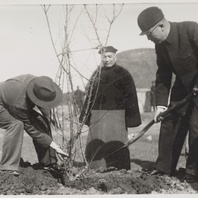
Item
Planting plum trees at Wang Jingwei’s tomb
RNG foreign minister Chu Minyi oversees the planting of young plum trees on Meihuashan (Plum Blossom Mount) in Nanjing, in the vicinity of Wang Jingwei’s tomb. The plum was (and remains) the national flower of the Republic of China, and the area around Wang Jingwei’s tomb was planted with plums as an act of patriotism after his death in late 1944. Very few photographs of Wang’s tomb survive.
Read More
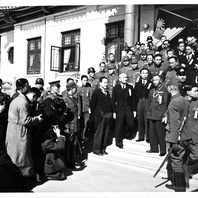
Item
RNG leaders on steps of Government Headquarters, November 1940
Flanked by civilian and military staff, Wang Jingwei, Zang Shiyi (the Manchukuo ambassador to the RNG) and Chu Minyi (RNG foreign minister) pose for photographs in front of the ceremonial hall (litang) in the national government compound in Nanjing after the signing of the Japan-Manchukuo-China Joint Declaration on 30 November 1940, through which RNG China recognised Manchukuo.
Read More
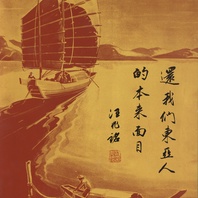
Item
Huan women Dong Ya ren benlai de mianmu (Restore to we East Asians our original countenance)
This unattributed print was produced in a special 1941 booklet commemorating Wang Jingwei’s visit to Japan in June of that year. The phrase “Huan wo Dong Ya ren benlai de mianmu” (Restore to we East Asians our original countenance) is a deliberate play on the expression “Huan wo heshan” (Return to us the rivers and mountains). The latter was probably the single most commonly used phrase in the wartime propaganda of the resistance. The print is taken from Huang Qingshu (ed), Wang zhuxi fang Ri jinian huakan (Special pictorial in commemoration of Chairman Wang’s visit to Japan) (Nanjing: Xuanchuanbu, 1941).
Read More
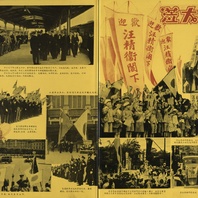
Item
An di Dongjing; li dashiguan (Arriving safely in Tokyo; visiting the embassy)
This photomontage is taken from Huang Qingshu (ed), Wang zhuxi fang Ri jinian huakan (Special pictorial in commemoration of Chairman Wang’s visit to Japan) (Nanjing: Xuanchuanbu, 1941). It includes images of Wang Jingwei arriving in Tokyo during his 1941 visit to Japan, and specifically his visit to the RNG embassy in Tokyo.
Read More
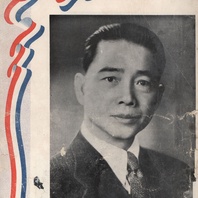
Item
H. E. Mr Wang Ching-wei
This supplement was published by the Ministry of Publicity (Xuanchuanbu) on the very day that Wang Jingwei officially “returned” to Nanjing to take up the reins of government under Japanese occupation. The symbols attached to this image (e.g., the KMT “white sun” ensign, and the colours of the ROC flag) suggest a “return” to pre-war norms. The presence of the Japanese is not so much as mentioned here.
Read More
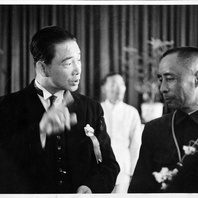
Item
Wang Jingwei with Zang Shiyi
Zang Shiyi (right), the Manchukuo ambassador to the RNG, speaks to Wang Jingwei prior to the both men signing the Japan-Manchukuo-China Joint Declaration on 30 November 1940, through which RNG China recognised Manchukuo. The Declaration was attached to the Sino-Japanese Basic Treaty, through which Japan formally recognised the RNG. Both documents were signed within the main RNG government compound in Nanjing.
Read More
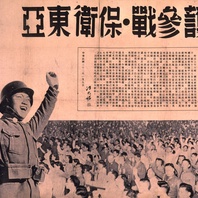
Item
Yonghu canzhan, baowei Dong Ya (Support the declaration of war; defend East Asia)
Poster of Chinese soldier celebrating the declaration of war on the Allies by RNG China. The poster reads “Yonghu canzhan, baowei Dong Ya” (Support the declaration of war; defend East Asia), and includes the text of Wang Jingwei’s declaration of war on the Allies on 9 January 1943. Note that some postwar owner of this poster has written “wei guomin zhengfu” (bogus National Government) to the right of the text by Wang Jingwei so as to clarify which Chinese administration was declaring war on this occasion.